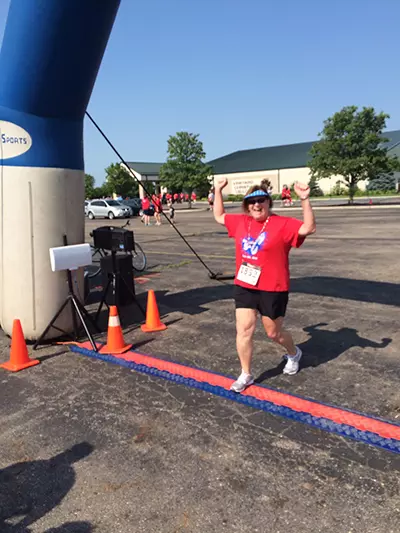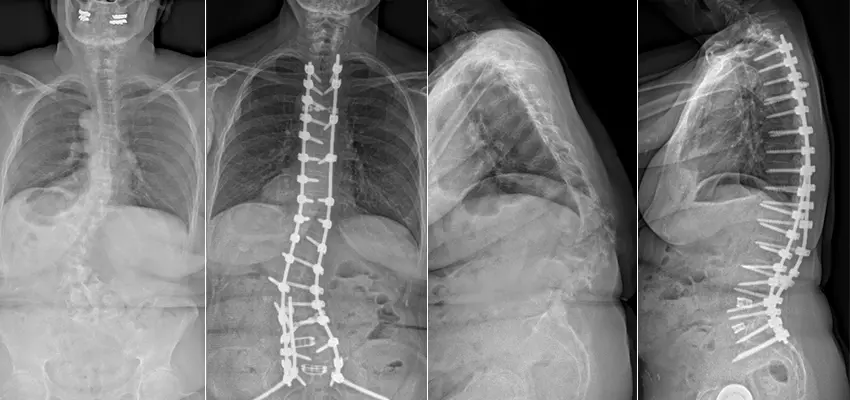- Home
- Patient Stories
- Adult Kyphoscoliosis - Peggy Stevens
Scoliosis surgery provides pain relief; gives patient new lease on life
By: Crystal Huff

Growing up, Peggy Stevens watched her mother struggle with scoliosis and a subsequent later-in-life surgery which failed to correct it. So, when Peggy was diagnosed with scoliosis at the age of 30, she accepted it as something she would have to live with and decided to put off surgery as long as possible.
Peggy says her mom’s spine continued to curve as she got older. She eventually became so deformed that it made it difficult to walk. “My mom, Jean, was 60 when she finally had surgery because it was her last resort. Otherwise, she would end up in a wheelchair,” says Peggy. A few years after Jean’s spine-correcting surgery, she broke a rod that had been surgically placed to help straighten the spine and did not want to have it repaired. Peggy says watching her mom go through the process made her feel discouraged about having her own surgery.
In 2004, Peggy was a first-grade reading teacher in Columbus, Ohio. “My back pain really increased in that role. As a reading teacher, I would spend a lot of time leaning over a table while working with my students.” Peggy made the decision to retire in 2005 and hoped to have more time to focus on reducing her back pain by exercising and getting stronger.
However, her pain and discomfort continued to get worse. Peggy says, “By 2012, long car rides were almost unbearable. The bottom of my rib would rub my hip bone due to the curvature of my spine.”
Peggy began researching surgical treatment and surgeons. In the fall of 2013, she was scheduled for surgery but suffered a setback when she and her husband, Rick, were involved in a bad motorcycle accident. Peggy ended up with six broken ribs and a broken shoulder, so her surgery had to be postponed. Also during this time, Rick’s spinal stenosis condition worsened and his need for surgery became a top priority.
Determined not to let the setback derail her pursuit of treatment, Peggy used this time to continue her research. She found an online support group who armed her with the right questions to ask during pre-op visits with her surgeon. After asking detailed questions, she realized her current surgeon may not be the right fit for her. “I couldn’t settle for just any surgeon at this point. I needed the best of the best and it’s very important to fully trust your doctor.” Her new online support group led her to Washington University Orthopedics spine specialists in St. Louis.
Peggy was still living in Columbus at the time, but decided to make the trip to St. Louis to meet with the nationally-renowned orthopedic surgeons at Washington University School of Medicine at Barnes-Jewish Hospital. Peggy was very impressed during her first consultation with Jacob Buchowski, MD, MS. “I did a lot of research. I had seen four or five surgeons at this point. By the time I saw Dr. Buchowski, I was prepared with questions. He answered all my questions with confidence and zero arrogance. He has a very calming manner.”
“By the time I evaluated Peggy, she had developed a severe spinal deformity. She not only had scoliosis, but was also pitched forward,” says Dr. Buchowski, who diagnosed Peggy with adult kyphoscoliosis resulting in coronal and sagittal imbalance. To treat her condition, Dr. Buchowski recommended a posterior spinal fusion with instrumentation from the upper thoracic spine to the sacrum and pelvis.
Peggy was scheduled for surgery with Dr. Buchowski in the fall of 2014, and she and her husband rented an apartment in St. Louis in preparation for her surgery and post-operative care. Every step of the way, Peggy was in constant contact with Dr. Buchowski’s nurse. Peggy recalls her care team always being available to answer questions and reassure her.
“Her surgery went beautifully. By performing a fusion from the T3 vertebra in the upper thoracic spine to the tailbone and pelvis, and performing osteotomies (surgical cutting of the bone) to allow greater correction of the deformity, we were able to straighten and realign her spine substantially,” Dr. Buchowski says. Over the years, Peggy’s height shrunk from five foot, eight inches down to five foot, two inches. After her surgery she regained almost three inches of her height.

Above: Peggy's preoperative and postoperative X-Rays.
Peggy says, “Going into this surgery, I just prayed that my pain would not increase and the progression of the kyphosis would be stopped. I never expected my back pain to be alleviated; I didn’t even know that was an option.” Peggy recently had her five-year follow up visit with Dr. Buchowski where she reported being more than 90% better than she was prior to her surgery.
“This surgery changed my life. I may not be able to do things the same way I did before, but my pain is gone and I managed to figure out new ways to do things. I just had to get creative.” She changed the way she ties her shoes and works in her to accommodate her range of motion.
Peggy says that looking back, she feels having to postpone her surgery due to the motorcycle accident was a blessing in disguise. Peggy says, “I knew I would eventually need surgery but I was willing to wait for the science and technique and availability to improve. The accident was horrific, but it allowed me the time I needed to find the absolute best doctor for me.”
Eight months after Peggy’s surgery, she walked her first 5K race and completed it in one hour and one minute. Peggy says, “I worked hard at recovery to even be able to participate and have since completed three 5K events.”